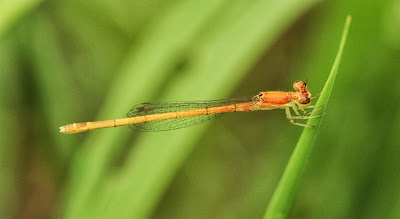Asahina (1997) describes two forms of Indocnemis orang. The first was originally described by Foerster in 1907 as Trichocnemis orang. The second form (forma kempi) was described by Laidlaw in 1917 as Indocnemis kempi. In 1985 Asahina lumped them, but in 1997 he writes "Now I am changing my previous idea (1985a), in which
kempi (1917) was synonymized with
orang (1907), though the former was recognized as a large-sized form of the latter." He then discusses I. orang based on specimens from Cuc Phuong and I. orang, forma kempi, based on specimens from Tam Dao. These belong to the same species, according to Asahina, based on the form of the penile organ.
Indeed, when I ran into a smaller version of I. orang in Cuc Phuong, with a different thorax pattern, I first thought it would be a different species from the I. orang I know from Ba Vi and Tam Dao. For the time being, let's go with Asahina's interpretation.
This is a spectacular species of forested streams, where males occupy territories on large wet rocks and boulders. Below some photos of both forms.
 |
| Indocnemis orang, male from Cuc Phuong. Note reduced thoracic stripes. |
 |
| Indocnemis orang, f. kempi, from Tam Dao |
 |
| I. orang, f. kempi from Tam Dao |
 |
| And another male from Tam Dao |
 |
| Female I. orang, f. kempi (presumably) from Tam Dao |



















































